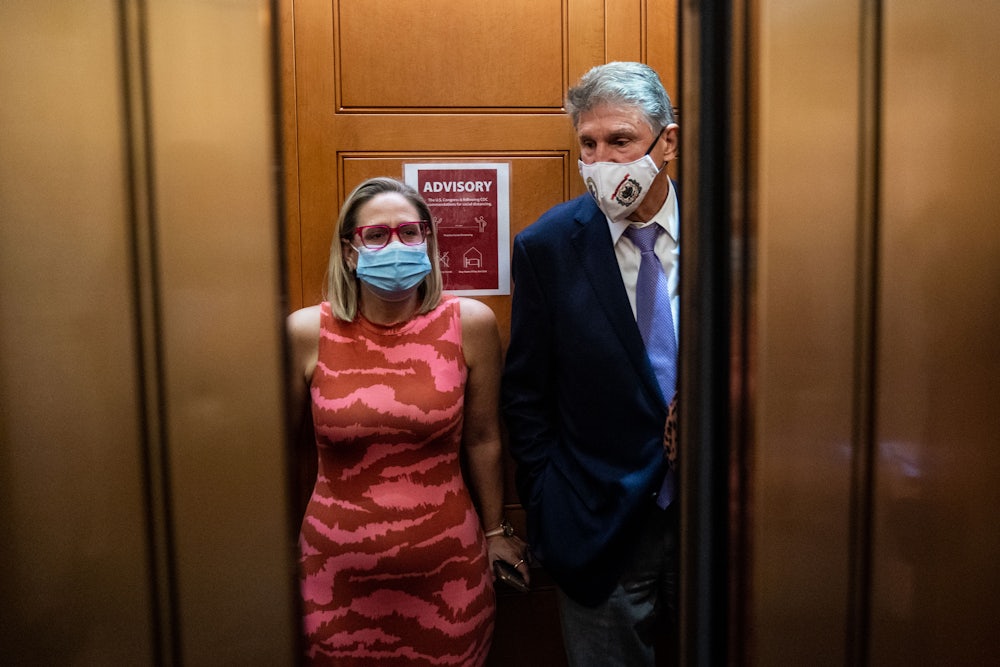Even as top Democrats were predicting
that they were finally—really, truly!—on the verge of cementing an agreement on
Joe Biden’s Build Back Better reconciliation package, West Virginia Senator Joe
Manchin was still throwing a wrench into the deal’s progress by reportedly
nixing the already watered-down paid family leave portion of the bill.
It was the latest sign that as Democrats said they were actually following through on their urgent calls finally to figure out some agreement, the internal forces (read: the two moderate Democratic senators who have been impeding this bill the whole time) were still slowing things down.
For any congressional Democrat, Wednesday was a flurry of fast-moving negotiations. By Thursday morning, the White House had announced that Biden would join a 9 a.m. closed-door Democratic Caucus meeting to update lawmakers on the reconciliation package and infrastructure deal. Then, around 11:30 a.m., he would deliver remarks to the rest of the country.
It wasn’t clear what this meant. The Congressional Progressive Caucus was set to meet right after the all-hands Democratic meeting. One source I texted Thursday morning responded with a “shruggie” emoji when I asked if this meant there was a deal (that was around 8 a.m., though). House Democrats were still standing opposed to shrinking the package to around $1.5 trillion or lower by dramatically slimming down various programs in the reconciliation proposal, something Manchin has been eyeing throughout the process.
In truth, there hasn’t been a moment when the desires of Manchin and Senator Kyrsten Sinema haven’t had to be front and center in Democrats’ considerations. Case in point: a two-page summary of spending priorities and revenue offsets for a possible $1.5 trillion Build Back Better reconciliation deal that circulated among Democratic lobbyists, outside groups, and congressional offices on Wednesday. Importantly, the summary detailed Sinema’s priorities.
The document, obtained by The New Republic on Wednesday, offered a breakdown of offsets and spending for a top-line reconciliation bill price tag of $1.5 trillion. It gives a short line-by-line list of important offsets and spending programs in the deal. The document was passed along by a Democratic source. TNR could not verify the exact origin of the document, but three Democratic sources confirmed its authenticity and where it had been circulating. Given the volatility of the situation, some of the numbers may be out of date, but the document provides an interesting window into the special consideration being given to Sinema.
The first page lists 13 offsets that are in play, with the caveat that some “scores are from [the Joint Committee on Taxation], others are estimates from [the Senate Finance Committee] or outside experts.” The document notes that “Sinema[’s] desired offsets are in italics,” and it listed five such revenue sources preferred by the Arizona senator, one of the staunchest holdouts in the negotiations. The document did not include any details on Senator Joe Manchin’s preferences. He has been the other main holdout.
Sinema’s offset priorities included various taxation programs that affect large businesses or the wealthy, such as “tightening language around the net investment income tax,” which the document said would yield $250 billion. The document also lists a billionaires’ income tax recently unveiled by Senators Ron Wyden (chair of the Senate Finance Committee), Elizabeth Warren, and Angus King as a priority for Sinema—although on the amount of revenue for this tax, the document said “?$$$$ (I’ve heard $300 B).” The other italicized points are a 15 percent alternative minimum tax on earnings for big corporations, and “Stock Repurchase,” which seemed to reference requiring businesses to show some corporate profits as taxable income, such as higher stockholder dividends or higher corporate income.
Other offsets in the breakdown that are not part of the Sinema list include rescinding the Trump prescription rebate rule, with a $135 billion offset estimate; new IRS enforcement revenues, with an offset estimate of $200 billion; and a “Limitation of Deduction of Interest,” with a $35 billion offset estimate. The list of offsets also includes an estimated $500 billion offset for “dynamic scoring,” a controversial approach to budgeting that predicts tax cuts cover lost revenue and create growth.
The first page of the document also says that increasing the corporate tax rate is in play “in case money is needed at the end of the process,” with a revenue estimate of $100 billion per “1 percent increase.”
The second page lists 13 spending programs “at the top of the list for the BBB reconciliation plan” with “expected duration” of each program. The Child Tax Credit tops the list, with a price tag estimate of $100 billion for one year. Childcare assistance comes in at $100 billion for one year. For paid family leave, the duration is four weeks at $75 billion. For “Universal Pre-K” the duration estimate is one to three years at $200 billion. A “SALT Patch” (shorthand for a state and local tax deduction patch) is listed but with no price tag and a note that the “$ score depends on how structured; if they push it out/delay it (as opposed to repeal), it raises revenue, but the belief is a patch will be put in place for SALT and many/all of the limitations placed in [Tax Cuts and Jobs Act of 2017] will be gone forever. TCJA’s limitations on SALT expire in 2025.” (TCJA is Hillspeak for the Trump tax cuts.)
The remaining bullet points, which are mostly self-explanatory, except for the CHIP reauthorization—which stands for Child Health Insurance Program reauthorization—are as follows:
· Affordable Housing $200B
· Pell Grant Extension $1B
· Expand ACA credit (1 year) $50B
· Address Medicaid Gap (2 years) $50B
· Expand Medicare $250B
· Expand Medicaid Elder Care $150B
· CHIP reauthorization $10B
The document concludes by saying “Total = $1.5 Trillion and change (this doesn’t include SALT). Programs, dollar amounts, and durations are subject to change.”
Again, none of this is set in stone. Between the time I initially obtained the document and publication, it seemed like Democrats were dumping the billionaire tax and then putting it back in the reconciliation package. Later in the day, paid family leave seemed to be off the table, also (but it could feasibly be back in the package by Thursday morning).
But the document does lay out how a $1.5 trillion reconciliation package would generally give a haircut to prioritized programs for Democrats looking to pass the package immediately. No program or offset goes below $10 billion or above $500 billion.
Manchin has said he would like to see a reconciliation bill at around $1.5 trillion. Progressives, from the beginning, have been hoping for something higher—as much as four times that.
The two-page summary provides a brief overview of extremely fluid and technical discussions going on among lawmakers and their aides and outside groups and lobbyists with various interests in the bill. But it also offers a window into the kind of distilled information lawmakers and advisers are receiving as they try to navigate the chaotic negotiations.
So much of this is in flux as of Wednesday evening. But one crystal clear fact from the summary is that Sinema’s various preferences constitute one of the most decisive parts of these negotiations. Democrats interested in the talks are trying to keep her enigmatic whims in mind.








